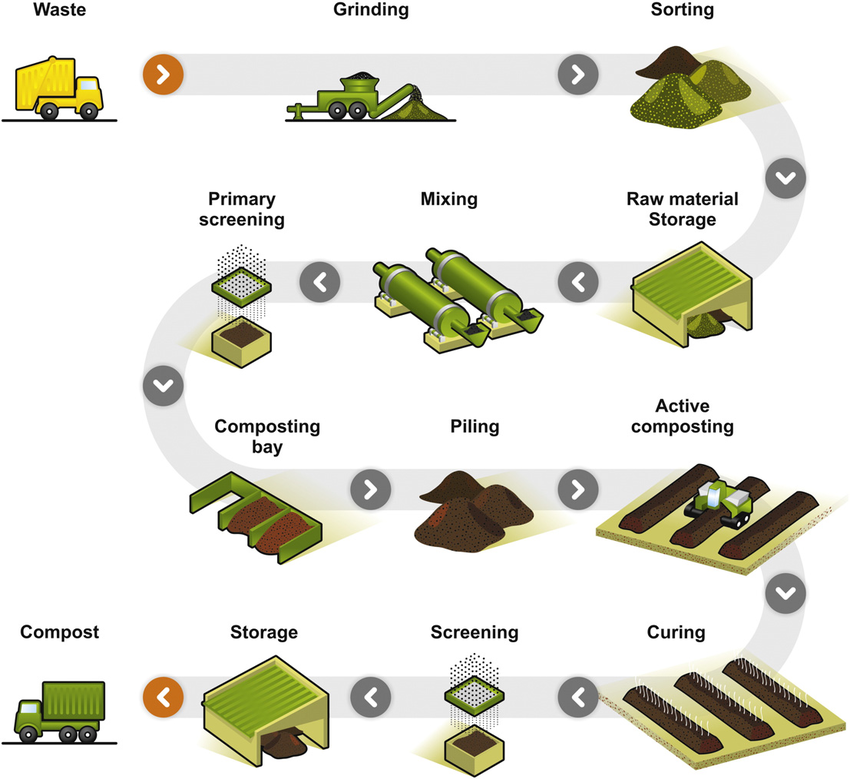🌱 AP Environmental Science Unit 8 Notes
8-10% of The AP Exam
Topics
8.1 Sources of Pollution
8.2 Human Impacts on Ecosystems
8.3 Endocrine Disruptors
8.4 Human Impacts on Wetlands and Mangroves
8.5 Eutrophication
8.6 Thermal Pollution
8.7 Persistent Organic Pollutants (POPs)
8.8 Bioaccumulation and Biomagnification
8.9 Solid Waste Disposal
8.10 Waste Reduction Methods
8.11 Sewage Treatment
8.12 Lethal Dose 50% (LD50)
8.13 Dose Response Curve
8.14 Pollution and Human Health
8.15 Pathogens and Infectious Diseases
These notes are based on Mr Jordan Dischinger-Smedes’s YouTube videos and the fill in template notes for these videos created by Carolyn Kelleher Mendonca. Some changes were made. Videos available here.
Good luck on the AP Test! 🩷
8.1 - Sources of Pollutants
Point vs. Nonpoint Pollutant Sources
Point Source
Pollutant that enters environment form one place
You can “point” to it
Non-point source
Pollutants entering the environment from multiple places
Difficult to “point” to one individual source
Must-Know Pollution Examples
Point Source
Animal Waste runoff from a CAFO (Ammonia and fecal coliform)
Emissions from smokestack of a coal power plant (CO2, NOx, SO2, PM)
BP oil spill (hydrocarbons, benzene)
Nonpoint Source
Urban Runoff (motor oil, nitrate fertilizer, rad salt, sediment)
Pesticides sprayed on agricultural fields; carried by wind and washed off large agricultural regions into bodies of water
Animal waste runoff
Estuaries and bays are polluted by many nonpoint pollution sources from the large watersheds that empty into them
Pollutants vs. Pollution
Pollutants
Specific chemicals or groups of chemicals from specific sources with specific health effects
Much more likely to earn you FRQ credit
Pollution
Vague, nondescript term for any substance that is harmful to the environment.
Not acceptable on an APES FRQ
Exceptions:
Specific categories of pollution
Thermal pollution
Noise pollution
Sediment pollution
8.2 - Human Impacts on Ecosystems
Range of Tolerance
Organisms have a range of tolerance for abiotic conditions in their habitat. Ex: pH, temperature, salinity (saltiness), sunlight, nutrient levels (ammonia, nitrate, phosphate)
Organisms also have range of tolerance for pollutants that human activities release into their habitats
Pollutants cause physiological stress such as
Limited growth
Limited reproductive functions
Difficulty respiring (breathing), potentially asphyxiation (suffocation)
Limited growth
Death (if concentration of pollutant is high enough)
Environmental Effects of Acid Rain
Aquatic species have diff. pH tolerances.
pH Tolerance
As pH decreases (more acidic) outside optimal range for a species, population declines.
When pH leaves range of tolerance, they cannot survive at all, due to:
Aluminum toxicity
Disrupted blood osmolarity (Na+/Cl- balance disrupted at low pH)
Indicator species can be surveyed and used to determine conditions of an ecosystem (soil, water, etc.)
Ex: high whitemoss pop. indicates pH < 6.0
High crustacean pop. indicates pH > 6.0
Temperature Tolerance of Reef Algae
Coral reef = mutualistic relationship between coral & photosynthetic algae called zooxanthellae; algae supply sugar & coral supply CO2 + detritus (nutrient containing org. matter.)
Algae have narrow temperature tolerance and leave the reef when temp. rises
Pollutants from runoff (sediment, pesticides, sunscreen) can also force algae from reef
Coral lose color & become stressed and vulnerable without algae (main food source)
Human impacts on Coral Reef
Humans disrupt coral reef ecosystems via GHG emissions (warming ocean temperature and bleaching coral)
Overfishing decreases fish populations in coral reef ecosystem & bottom trawling can break reef structure and stir up sediment
Urban and agricultural runoff also damages coral reef ecosystems
Sediment pollution: sediment carried into ocean by runoff makes coral reef waters more turbid, reducing sunlight (photosynthesis)
Toxicants: chemicals in sunscreen, oil from roadways, pesticides from ag. runoff
Nutrients (P/N): ammonia from animal waste, nitrates/phosphates from ag. or lawn fertilizers
Oil Spill Effects
Hydrocarbons in crude oil (petroleum) are toxic to many marine organisms and can kill them, especially if they ingest (eat) the oil or absorb through gills/skin
Other physiological effects:
Decreased visibility and decreased photosynthesis due to less sunlight penetrating water surface
Oil sticking to bird feathers
Oil sinking to bottom and killing bottom-dwellers due to: direct toxicity or suffocation
Oil can wash ashore and decrease tourism and kill fish, decreasing fishing industry revenue, hurt restaurants that serve fish
Oil can settle deep in root structures of estuary like mangroves or salt marshes
Can be toxic to salt marsh grasses, killing them and loosening their root structure, leading to coastline erosion
Can remove used by fish & shellfish for breeding grounds
Oil Spill Clean up
Oil spills can occur when an underwater oil well explodes/blows out (BP Gulf Spill) or when a tanker runs into a rock/iceberg and is punctured (Exxon Valdez)
Cleanup can involve booms on surface to contain spread and ships with vacuum tubes to siphon oil off of the surface or devices to skim It off
Physical removal of oil from beach sand and rocks with towels, soaps, and shovels.
Chemical dispersants sprayed on oil slicks to break up and sink to the bottom
Clears up surface, but can smother bottom-dwellers
Dispersant chemicals may be harmful
Burning oil off surface
8.3 - Endocrine Disruptors
Chemicals that interfere with the endocrine systems of animals
Bind to cellular receptors meant for hormones, blocking the hormone from being received, or amplifying its effects.
Human medications that pass through urine & into sewage or are flushed down toilet are a common source (meant to influence human hormones, so they can also disrupt animals)
Example: atrazine (herbicide) binds to receptors of cells that should convert into testosterone in male frogs, leading to: high estrogen in males, low sperm count, even feminization (development of eggs in the testes or ovary formation)
Atrazine- broad-spectrum herbicide used to control weeds & prevent crop loss
Applied to ag. fields, runoff into local surface or groundwater or is carried by wind
Can contaminate human well-water, or enter body via unwashed produce
DDT - broad-spectrum insecticide that was phased out, but still persists in environment
Applied to agriculture fields, runs off into local surface or groundwater or is carried by wind
Phthalates - compounds used in plastic and cosmetic manufacturing
Enter surface & groundwater via intentional dumping of trash, or chemical waste from plastic/cosmetic factories improperly disposing of waste, landfill leaching
Also found in some cosmetics & plastic food containers (#3 plastic & “fragrance”)
Lead, arsenic, Mercury - heavy metals
Many human medications that enter sewage via human urine or flushed meds
Mercury - naturally occurring in coal, released by anthropogenic activities
Coal combustion, trash incineration, burning medical waste, heating limestone for cement
Attaches to PM released by burning & deposits in soil/water wherever PM settles
Can be released if coal ash stored in ponds overflow & runoff
Endocrine disruptor: inhibits estrogen and insulin (interferes with menstrual cycle and ovulation)
Teratogen:
Pregnant women can reduce risk by eating less
Bacteria in water sources convert mercury to methylmercury which is highly toxic to animals
(Neurotoxicant - damages central nervous system)
Arsenic & Lead - Naturally occurring element in rocks underground that can dissolve into drinking water; Natural release into groundwater can be worsened by mining
Anthropogenic sources: formerly in pesticides applied to ag. fields (can still linger in soil, wood treatment chemicals to prevent rot, coal combustion & ash
Carcinogenic (lungs, bladder, kidneys) & endocrine disrupting
Endocrine disruptor (specifically glucocorticoid system)
Can be removed with water filters
Lead - found in old paint (in homes), old water pipes, soil contaminated by PM from vehicle exhaust before lead was phased out of gas in 70s
Also released in fly ash (PM) of coal combustion
Neurotoxicant (damages central nervous system, especially in children)
Endocrine disruptor
Can be removed with water filters
Coal Ash - can be a source of Mercury, lead & arsenic
Can attach to fly ash(PM) from smokestacks and be carried by wind, deposited in ecosystems far away.
Both fly and bottom coal ash are often stored on site in ponds, dug into soil & lined with plastic (sometimes)
Ponds can leach into groundwater, contaminating it with arsenic, lead & mercury.
Ponds can overflow & runoff into nearby surface waters & agricultural fields
8.4 Human Impacts on Wetlands and Mangroves
An area with soil submerged/saturated in water for at least part of the year, but shallow enough for emergent plants
Wetland plants have adapted to living with roots submerged in standing water (cattails, lily pads, reeds)
Ecosystem Services of Wetlands
Provisioning: habitat for animal & plant foods
Regulating: groundwater recharge, absorption of floodwater, CO2 sequestration
Supporting: H2O filtration, pollinator habitats, nutrient cycling, pest control
Cultural: tourism revenue, fishing license, camping fees, educational/medical research
Threats to Wetlands
Pollutants - nutrients (N/P), sediment, motor oil, pesticides, and endocrine disruptors
Development - wetlands can be filled in or drained to be developed into homes, parking lots, stores, or agricultural land
Water diversion upstream for flood control, agriculture, or drinking water reduce flow and dry up wetlands (ex: Everglades)
Dam construction for flood control/hydroelectric reduces water & sediment (N/P) flow to wetlands
Overfishing: disrupts food web of wetlands (decrease in fish predators, increase in prey)
Solutions to Watershed Pollutants
Riparian buffers - strips of vegetation planted next to streams or other water bodies
Cover Crops - plants grown primarily to benefit the successful growth or other future crops
Mangrove: A woody tree of shrub that lives along sheltered coastlines within the tropical or subtropical latitudes
8.5 - Eutrophication
Eutrophication Process
Because they’re limiting nutrients in aquatic ecosystems, extra input of N & P lead to eutrophication (excess nutrients) which fuels algae growth. Algae bloom covers surface of water, blocking sunlight & killing plants below surface
Algae eventually die-off; bacteria that break down dead algae use up O2 in the water (because decomposition = aerobic process)
Lower O2 levels (dissolved oxygen) in water kills aquatic animals, especially fish.
Bacteria use up even more O2 to decompose dead aq. animals
Creates positive feedback loop: less O2 → more dead org. → more bacterial decomposition → less O2
Cultural Eutrophication
Anthropogenic nutrient pollution (N & P) that leads to eutrophication
Algae bloom due to increase of N/P → decreased sunlight → plants below surface die → bacteria use up O2 for decomp. → hypoxia (low O2) & dead zones
⛰ Major N/P sources:
Discharge from sewage treatment plants(N/P in human waste & phosphates in soaps/detergents)
Animal waste from CAFOS
Synthetic fertilizer from ag. fields & lawns
Oligotrophic Waterways
Waterways with low nutrient (N/P) levels, stable algae pop, and high dissolved oxygen
Can be due to lack of nutrient pollution, or age of the body of water
Aquatic ecosystems naturally undergo succession
Sediment buildup on bottom (benthic zone) leads to higher nutrient levels
Overtime, ponds naturally shift from oligotrophic, to mesotrophic, to eutrophic
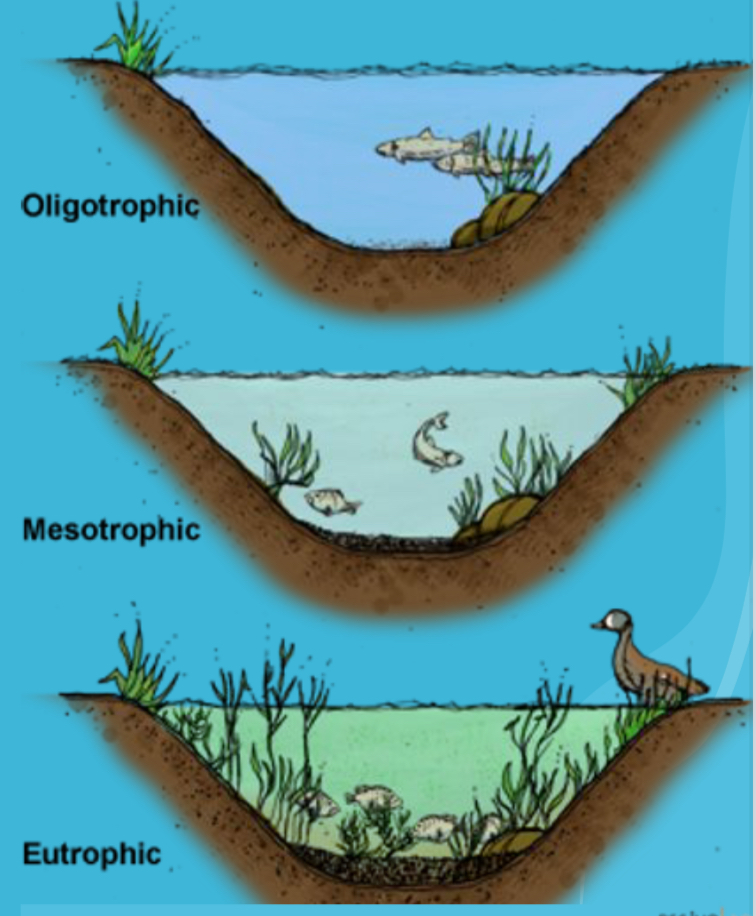
Dissolved Oxygen & Dead Zones
Decrease in dissolved oxygen (hypoxia) is what causes a dead zone
All aquatic life requires DO (dissolved oxygen) in water for respiration
As DO decreases, fewer species can be supported
Most fish require at least 3.0 ppm to survive, 6.0 ppm to reproduce
8.6 - Thermal Pollution
Solubility of Oxygen & Temperature
Solubility is the ability of a solid/liquid/gas to dissolve a liquid (oxygen dissolving into water in this case)
There Inverse relationship between water temperature & dissolved oxygen (DO)
As water temperature increases, DO (dissolved oxygen) decreases

Thermal Pollution: When heat released into water has negative effects on organisms living in the water
Heat increases respiration rates of aquatic organisms (thermal shock)
Hot water also has less O2
This can lead to suffocation without enough O2 to support respiration
Sources of Thermal Pollution
Power plants use cool water from surface/groundwater sources nearby to cool steam used to turn a turbine back into water to reuse
Steel mills, paper mills, and other manufacturing plants also use cool water to cool down machinery & return warmed water to local surface waters
Urban stormwater can also cause thermal pollution due to heat from blacktop/asphalt
Nuclear power plants require especially large amounts of cool water to cool steam back into water & to cool the reactor core.
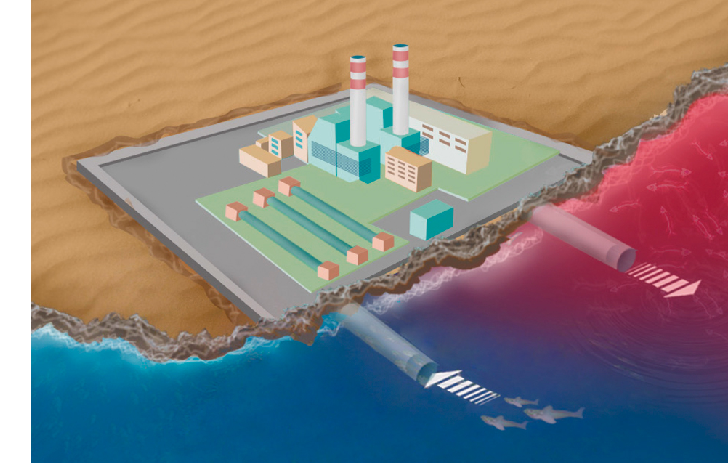
Cooling Towers
Cooling towers/ponds are used to cool steam back into water & to hold warmed water before returning to local surface water
Already standard in nuclear power plants, but can be optimized to cool water better or hold it longer before returning to nearby surface waters
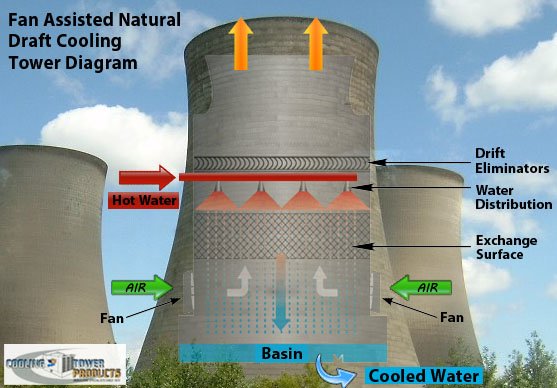
8.7 - POPs Persistent Organic Pollutants
POPs - Persistent (long-lasting) Organic (carbon-based) Pollutants
Synthetic (human-made) compounds that do not easily break down in the environment; accumulate and buildup in water and soil
Fat-soluble, meaning they also accumulate and persist in animals’ fat tissue instead of passing through the body (don’t easily dissolve into blood/urine)
Can slowly be released from fatty tissue into the bloodstream and impact brain & organs over time (especially reproductive system)
Could potentially eventually effect brain function.
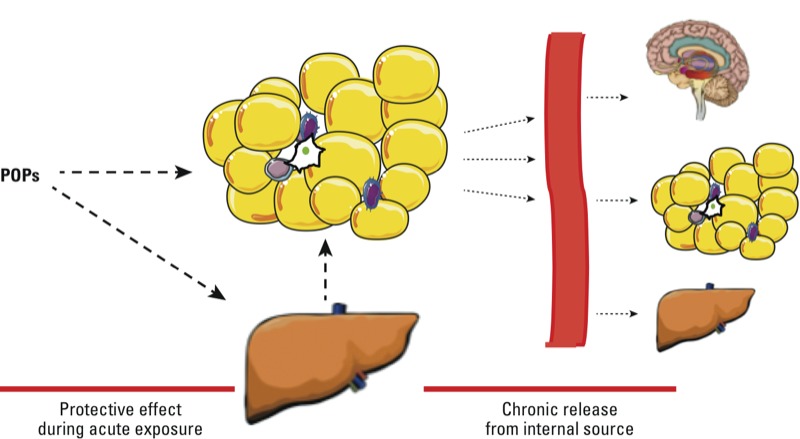
Examples & Sources of POPs
*DO NOT HAVE TO MEMORIZE*
DDT(outdated insecticide)
PCBs(plastic/paint additive)
PBDEs (fire-proofing)
BPA (plastic additive)
Dioxins (fertilizer production & combustion of waste and biomass)
Phthalates (Plastics)
Perchlorates(rocket/missile fuel, fireworks)
Pesticides
DDT was widely used as an insecticide before phaseout in most dev. nations
Still persists in soils and sediments in aq. ecosystems and builds up in the food web
Medications (Pharmaceutical compounds)
Steroids, reproductive hormones, antibiotics, that pass through human bodies & into sewage release from treatment plants
Persist in streams/rivers & disrupt aq. organisms’ endocrine function
Dioxins
A byproduct of fertilizer production & burning of medical waste, FFs, biomass
90% of human dioxin exposure comes from animal fats (meat, dairy, fish) since dioxins buildup in animal fat tissue
Examples & Transport of POPs
PCBs
Additives in paint and plastics, released into aquatic ecosystems by industrial wastewater
Toxic to fish, causing spawning failure and endocrine disruption
Reproductive failure & cancer in humans
Human exposure comes through animal products
Perchlorates
Given off by rockets, missiles, and fireworks
Especially common near military testing sites or rocket launch pads
Remain in soil and can leach into groundwater or runoff into surface waters
POPs travel long distances through wind & water, impacting ecosystems far away
Wastewater release from industrial processes, leachate from landfills or improperly buried industrial waste, fertilizer/pesticide production, emissions from burning waste/biomass
Enter soil/water, eaten by animals, stored in their fat, eaten by humans or taken in via drinking water
8.8 - Biomagnification & Bioaccumulation
Bioaccumulation
Absorption and concentration of compounds (especially fat-soluble like POPs) in the cells & fat tissues of organisms
Because fat-soluble compounds like POPs and methylmercury don’t dissolve easily in water, they don’t enter blood easily & don’t leave in urine easily
Instead they build up in tissue
This leads to them building up to reach higher and higher concentrations in the organism over time
Biomagnification
Increasing concentrations of fat-soluble compounds like methylmercury and POPs in each level up the trophic pyramid or food web/chain
Biomagnification begins with POPs or methylmercury in sediments or plants in an ecosystem (phytoplankton, grass)
Primary consumers (zooplankton, bottom feeding fish, insects) take in POPs by eating producers, causing bioaccumulation of POPs in their tissues
Secondary consumers eat primary consumers and take in the POPs in their tissues
Because of the 10% rule, organisms at each successive trophic level need to eat more and more biomass to receive enough energy, leading to higher and higher POP levels over their lifetimes
Large predators like salmon, dolphins, and whales have highest POP/methylmercury levels
Biomagnification (DDT)
DDT was banned in many developed nations, but still persists in sediments of many bodies of water
Taken in by bottom feeders/zooplankton & biomagnified at higher trophic levels
Reach highest levels in top predators, esp. predatory birds like eagles & osprey
Causes thinning of the eggshells in these birds
Linked to massive pop. decline of bald eagle in US, which prompted passage of Endangered Species Act (73’)
Biomagnification (methylmercury)
Mercury is emitted from burning coal & by volcanoes, carried by wind, and deposited in water where bacteria convert it into toxic methylmercury
Taken in by phytoplankton & biomagnified at higher trophic levels
Reach highest levels in top predators, tuna, sharks, whales
Neurotoxicant: damages the central nervous system of animals
Human exposure to methylmercury & POPs comes from eating large predatory fish like tuna & salmon (and other seafood)
Damage to the human nervous system (esp. developing fetus) and disrupt reproductive system
8.9 - Solid Waste Disposal
MSW (Municipal Solid Waste)
Solid waste from cities (households, businesses, schools, etc.
Waste “stream” refers to flow of solid waste to recycling centers, landfills, or incineration (burning) facilities
Aka - trash, litter, garbage
Paper
Organics
E-Waste
Old computers, TVs, phones, tablets
Only ~2% of MSW; considered hazardous due to metals like led, mercury, cadmium (fireproof chemicals)
Can leach endocrine disruptors out of landfills if thrown away with regular MSW (should be disposed of at special facilities that recycle parts)
Sanitary Landfills
Sanitary Landfill is APES lingo for “landfill,” where developed nations dispose of trash; different than “dumps” which are just areas where trash is dumped, without the features below
Clay or Plastic bottom liner: layer of clay/plastic on the bottom of a hole in the ground; prevents (tries to at least) pollutants from leaking out into soil and groundwater.
Leachate Collection System: System of tubes and pipes at bottom to collect leachate (water draining through waste & carrying pollutants) for treatment and disposal
Methane Recovery System: System of tubes/pipes to collect methane produced by anaerobic decomposition in the landfill
Methane can be used to generate
heat or electricity
Clay Cap: Clay-soil mixture used to cover the landfill once it’s full; keeps out animals, keeps in smell, and allows vegetation to grow

Landfills generally have very low rates of decomposition due to low oxygen, water, and organic material combination
Since these 3 factors are rarely present together in landfills, little decomp. occurs and landfills typically remain about the same size as when they were filled
Things that should NOT be landfilled
Hazardous Waste (antifreeze, motor oil, cleaners, electronics, car batteries)
Metals like copper & aluminum (should be recycled)
Old tires; often left in large piles that hold standing water ideal for mosquito breeding
Things that SHOULD be landfilled:
Cardboard/food wrappers that have too much food residue & can’t be recycled
Rubber, plastic films/wraps
Styrofoam
Food, yard waste, and paper can and do go in landfills, but should be recycled or composted
Landfills have environmental impacts like groundwater contamination and release of GHG
Groundwater can be contaminated with heavy metals (lead, mercury), acids, medications, and bacteria if leachate leaks through lining into soil/groundwater beneath
Greenhouse gasses (CO2 and CH4- methane) are released from landfills due to decomposition; both contribute to global warming & climate change
NIMBY (Not in my backyard) = idea that communities don’t want landfills near them for a number of reasons
Smell and sights
Landfills can attract animals like rats and crows
Groundwater contamination concerns
Landfills should be located far from river, streams, and neighborhoods to avoid H2O cont.
Landfills are often placed near poor or low income communities that don’t have the time or voice to fight against these decisions.
Waste can be incinerated (burned) to reduce the volume that needs to be landfilled. Since most waste (paper, plastic, food) has hydrogen, carbon, and oxygen, it easily combusts at high temperatures.
Can reduce volume by 90%, but also releases CO2 and air pollutants (PM, SOx, NOx)
Bottom ash may contain toxic metals (lead, mercury, cadmium) & is stored in ash ponds, then taken to special landfills
Toxic metals can leach out of storage ponds or be released into the atmosphere
Can be burned to generate electricity (covered in 8.10)
Illegal ocean dumping occurs in some countries with few environmental regulations or lack of enforcement
Plastic especially collects into large floating garbage patches in the ocean
Can suffocate animals if they ingest (eat) it or entangle them so they can’t fly or swim and may starve
8.10 Waste Reduction
Reduce, Reuse, Recycle - The Three Rs
Reducing consumption is the most sustainable because it decreases natural resource harvesting and the energy inputs to creating, packaging, and shipping goods
Metal/reusable water bottles are the next most sustainable because they don’t require additional energy to create a product
Reusing - Taking old items are giving them a new life
Ex: Buying second hand clothes, using old wood pallets for furniture, washing plastic takeout food containers and reusing
Recycle = processing and converting solid waste material into new products
Ex: Glass being turned into glass again (closed-loop), plastic water bottles being turned into fabric for clothes/jackets (open loop)
Least sustainable of the three Rs due to the amount of energy to process and convert waste materials
Pros of Recycling
Reduces demand for new materials, especially metals and wood which cause habitat destruction & soil erosion when harvested
Reduces energy required to ship raw materials and produce new products (fewer FF comb, less CC)
Reduces landfill volume, conserving landfill space & reducing need for more landfills
Cons of Recycling
Recycling is costly and still requires significant energy
Cities that offer recycling services need to process, sort, and sell collected materials; prices change rapidly, leading to “recycled” materials often being thrown away
When citizens recycle items that shouldn’t be recycled (wrappers with food, styrofoam, etc.) it increases the cost for cities to sort & process
Organic Matter being decomposed under controlled conditions
Reduces landfill volume and produces rich organic matter that can enhance water holding capacity, nutrient levels of agricultural or garden soil
Produces valuable product to sell (compost)
Reduces the amount of methane released by anaerobic decomposition of organic matter in landfills
Should be done with a proper mix of “browns” (Carbon) to greens ~ 30:1
Should also be aerated and mixed to optimize decomposition (bacteria need O2 for decomposition)
Potential drawbacks include the foul smell that can be produced if not properly rotated & aerated and rodents or other pests that may be attracted
Waste from electronics (phones, computers, etc.) that often contain heavy metals (lead, merc, cadmium)
Can leach these toxic metals into soil & groundwater if disposed of in landfills or open dumps
Can be recycled and reused to create new electronics, but often sent to developing nations for recycling due to health hazards, less strict env. & worker protection laws in developing nations
Can be dismantled and sold to countries that extract valuable metals (gold, silver, platinum) from motherboards
Often burned or dumped due to less strict environmental regulations or lack of enforcement in developing nations
Waste can be incinerated (burned) to reduce the volume & also generate electricity; most waste (paper, plastic, food) = hydrogen, carbon, and oxygen so it easily combusts at high temp.
Same process as burning coal, NG, biomass
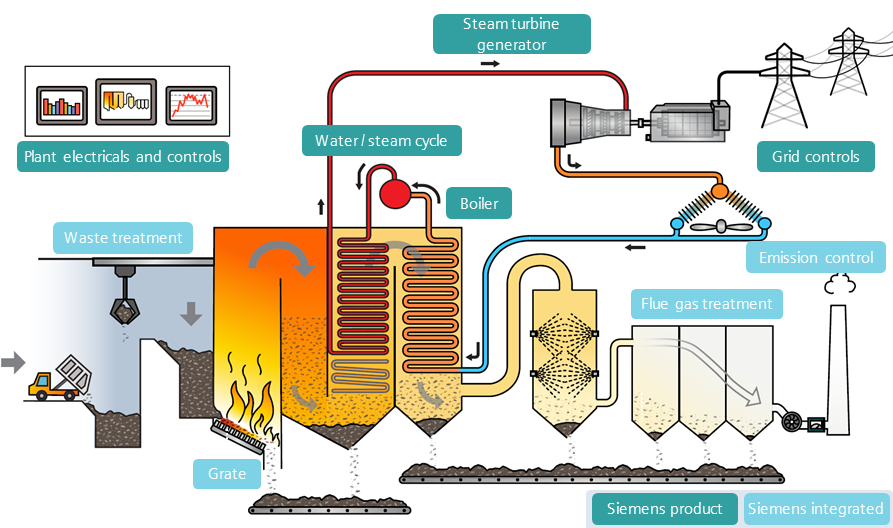
Methane Gas produced by decomposition in landfill can be collected with pipes & burned to generate electricity
Heat —> water —> steam —> turbine —> generator
Reduces landfill volume
Produces electricity without fracking or mining for FFs

8.11 Sewage Treatment
Water Treatment Process
Primary Treatment
Physical removal of large debris (TP, leaves, plastic, sediment) with a screen or grate
Secondary Treatment
Biological breakdown of organic matter (feces) by bacteria; aerobic process that requires O2
Tertiary Treatment (not always done!)
Ecological or chemical treatments to reduce pollutants/“nutrients”(nitrate, phosphate, ammonia)
Disinfectant
UV light, ozone, or chlorine is used to kill bacteria or other pathogens, such as e. Coli
Effluent: liquid waste (sewage) discharged into a surface body of water, typically from a wastewater treatment plant
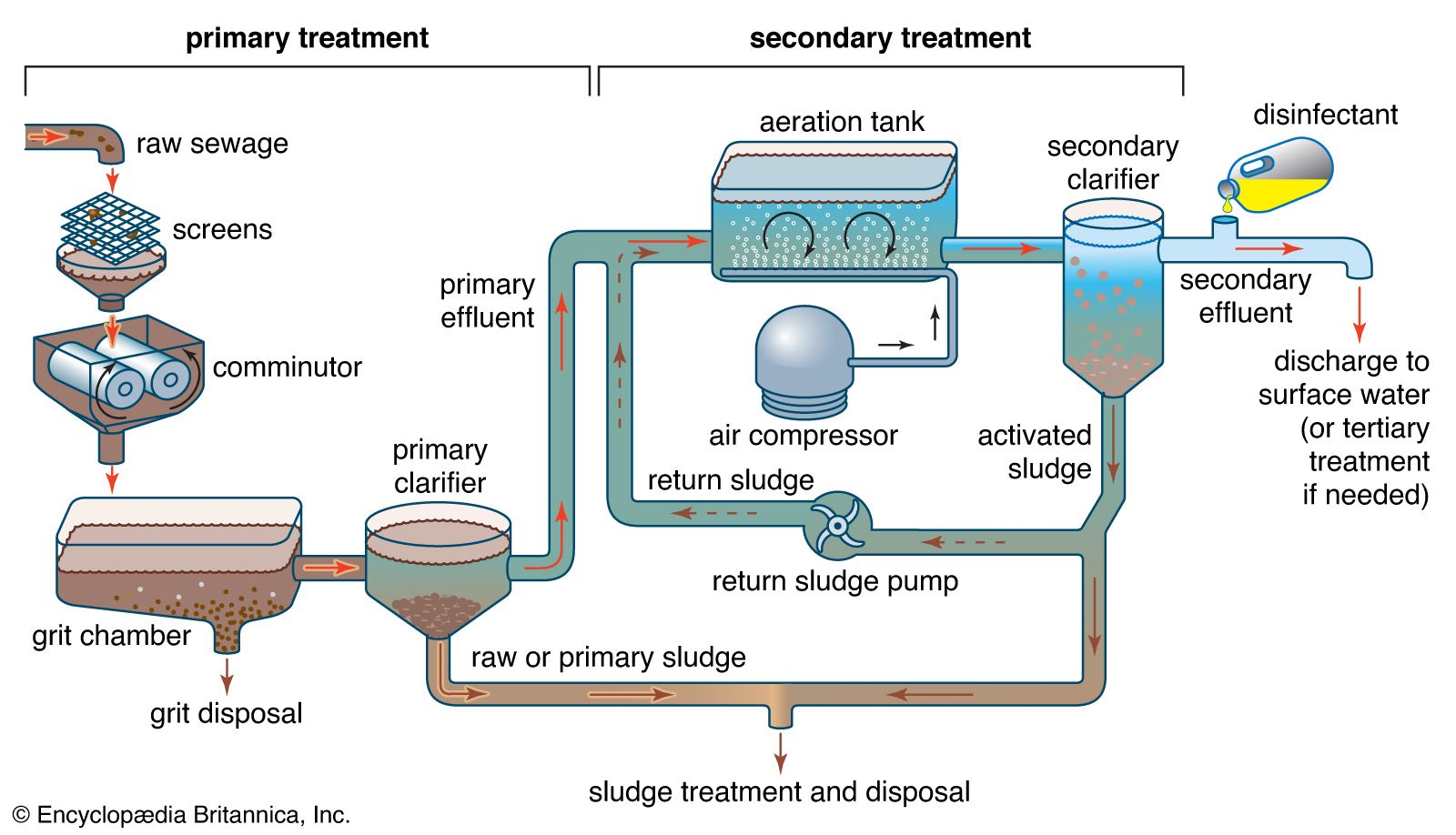
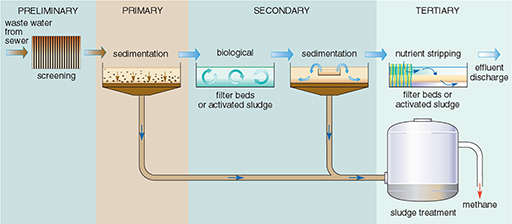
Aquifers are bodies of permeable rock that can contain or transmit groundwater. It is not an underground lake, it is permeable rock.
Surface runoff is water that flows over land and is a major component of the water cycle. Runoff causes erosion, eutrophication (excess nitrates and phosphates from fertilizers in the water supply lead to algae), and flooding.
An area where surface runoff drains is a watershed
Primary & Secondary Treatment
Sludge: inorganic, solid waste that collects at the bottom of tanks in primary and secondary treatment
Water is spun/pumped off to concentrate it further
Dry, remaining physical waste is collected to be put in landfill, burned, or turned into fertilizer pellets
After primary & secondary treatment, some plants go directly to disinfectant (UV, ozone, chlorine) & discharge into surface water, while some will use tertiary treatment to remove more nutrients before discharge
Tertiary Treatment
Chemical treatment uses chemical filters to remove more of the nitrates and phosphates from secondary treatment discharge
Critical step because effluent that is discharged into surface waters with elevated nitrate/phosphate levels leads to eutrophication
Expensive and not always used
Sewage Treatment Issues
Combined sewage systems can cause wastewater treatment plants to flood during heavy rains, releasing into surface waters
Beneficial b/c it treats storm water runoff normally, but causes overflow during heavy rains
Raw sewage release contaminates surface waters with:
E. Coli
Ammonia
Nitrates
Phosphates
Endocrine disruptors (medications)
Even treated wastewater effluent released into surface water often has elevated nitrate and phosphate levels and endocrine disruptors (medications passed through the body)
8.12 & 8.13 - LD50 & Dose Response Curve
Dose Response Studies & LD50
Studies that expose an organism to different doses of concentrations in order to measure the response (effect) of the organism
Independent variable (y axis) = concentration of the chemical (added to food, water, or air)
Dependent variable (x axis) = response measured in org. (usually death or impairment)
LD50 (lethal dose) refers to the dose or concentration of the chemical that kills 50% being studied (ex: arsenic LD50 in mice = 13 mg/kg)
LD50 data are usually expressed as:
mass (g, mg)/body unit mass (kg)
ppm - parts per million (in air)
mass/volume (in water of blood)
Dose Response Curve
The data from a dose response study, graphed with percent mortality or other effect on the y axis and dose concentration of chemical on x axis
Lowest dose where an effect (death, paralysis, cancer) starts to occur is called the threshold or the toxicity threshold.
Dose response curves are usually “s shaped”
Low mortality at low doses, rapid increase in mortality as dose increases, level off near 100% mortality at high dosage
ED50 & Other Dose Responses
ED50 refers to the dose concentration of a toxin or chemical that causes a non-lethal effect (infertility, paralysis, cancer, etc.) in 50% of the population being tested
Ex: the concentration of atrazine in water that causes 50% of frogs to become infertile
Same general “s-shape” as LD50 dose response curve, but at lower dose concentrations
Dose Response Data & Human Health
Dose-response studies for toxic chemicals are not done on humans; data from other mammals (mice, rats) are used to simulate human toxicity
To determine safe levels for humans, we generally divided LD50 or ED50 dose concentration by 1,000 for extreme caution
Acute vs. Chronic studies
Most dose-response studies are considered acute, since they usually only measure effects over a short period of time; they’re also isolated to a lab, so they don’t measure ecological effects of organisms dying (trophic cascades)
Chronic studies are longer-term and follow developmental impacts
Ex: study of fish from hatchlings to adults to study sexual maturation
8.14 - Pollution and Human Health
Routes of Exposure & Synergism
It’s difficult to establish exactly how toxic different pollutants are to humans because we have so many routes of exposure to so many different pollutants, that studying the effects of just one pollutant is difficult.
Routes of Exposure
Ways that a pollutant enters the human body
Lead → water pipes and paint chips
Ingestion / inhalation / skin
Mercury → seafood (tuna)
Ingestion / inhalation
CO → indoor biomass combustion
Inhalation
PM → dust, pollen, etc
Inhalation
Arsenic → rice, groundwater
Ingestion
Synergism
The interaction of two or more substances to cause a greater of them individually
Ex: Asthma caused by PM from coal PPs and COVID damaging lungs
Carcinogenic effect of asbestos combined with lung damage from smoking
Synergisms make it especially hard to pinpoint the exact effects of one specific pollutant on humans
Dysentery
⛰Bacterial infection caused by food or water being contaminated with feces (often from sewage release into rivers & streams used for drinking water)
Causes intestinal swelling and can result in blood in feces
Results in severe dehydration due to diarrhea (fluid loss)
Kills 1.1 million people annually, mostly in developing countries with poor sanitation and limited access to water filtration
💊🚰 Can be treated with antibiotics that kill the bacteria causing the infection and access to treated/filtered water that can rehydrate
Mesothelioma (asbestos)
A type of cancerous tumor caused by exposure to asbestos, primarily affecting the lining (epithelium) of the respiratory tract, heart, or abdominal cavity
Asbestos exposure comes primarily from old insulation materials used in attics, ceiling and flooring boards; when the insulation becomes physically disturbed, asbestos particles are released into the air & inhaled
Removal of asbestos-containing insulation material should be done by professionals with proper training and equipment that protects them from inhaling the asbestos
The area where asbestos is removed from should be sealed off from other areas in the building and well-ventilated during the removal process
Insulation without asbestos should be used to replace it
Tropospheric Ozone (O3)
Worsens respiratory conditions like asthma, emphysema, bronchitis, COPD
Limits overall lung function
Irritates muscles or resp. tract causing constriction of airways & shortness of breath
Irritates eyes
Sources: photochemical breakdown of NO2 (car exhaust, coal & NG combustion) 🚗💭 🏭
⛰ONLY HARMFUL IN TROPOSPHERE (beneficial in stratosphere)
8.15 - Pathogens and Infectious Diseases
Pathogens & Vectors
Pathogen
A living organism (virus, bacteria, fungus, protist, worm) that causes an infectious disease.
Infectious diseases are capable of being spread or transmitted (HIV, ebola, COVID-19); noninfectious diseases are not transmissible (heart disease, asthma, cancer, diabetes)
Pathogens adapt and evolve to take advantage of humans as hosts for their reproduction a spread (COVID-19 is a SARS-associated coronavirus that evolved to become especially effective at surviving and reproducing in humans)
Vectors
A living organism (rat or mosquito) that carry and transmit infectious pathogens to other organisms
Climate change is shifting equatorial climate zones north and south away from the equator.
This brings warmer temperatures to subtropical and temperate regions, where pathogens are more likely to survive
Warmer temperatures allow pathogens and their vectors (mosquitos) to spread north & south to parts of the world previously too cold
Many pathogenic bacteria and viruses survive and replicate better in warmer
Infectious Disease & Development
Less developed countries typically have higher rates of infectious disease
Less sanitary waste disposal; pathogens can reproduce in open waste areas where children may play or animals may scavenge & pass to humans
Less access to healthcare facilities and antibiotic medications to treat infectious diseases cause by bacteria & other pathogens
Lack of treatment/filtration for drinking water & sewage treatment exposes people to bacterial and viral pathogens in water, often from human waste
Tropical climates & more open-air living can expose people to vectors like mosquitoes; less money for vector eradication (spraying mosquito breeding grounds)
Plagues
Bacterial (pathogen) infection transmitted by fleas (vector) that attach to mice & rats (vectors as well)
Transmitted by flea bite, rodent contact or contaminated human fluids
Aka bubonic or black plague. Modern antibiotics are highly effective against it, but some isolated instances still occur
Tuberculosis (TB)
Bacterial (pathogen) infection that targets the lungs
Transmitted by breathing bacteria from body fluids (resp. droplets) of an infected person, which can linger in air for hours
Causes night sweats, fever, coughing blood; treatable in developed nations with access to powerful antibiotics
Leading cause of death by disease in the developing world ~ 9 million cases per year and 2 million deaths (for comparison ~ 2.8 million global deaths from Covid-19)
Malaria
Parasitic protist (pathogen) infection caused by bite from infected mosquitoes (vector)
Most common in sub-Saharan Africa (& other tropical regions of Middle East, Asia, South & Central America; recurring flu-like symptoms; kills mostly children under 5
West Nile
Virus (pathogen) infection caused by bite from infected mosquitoes (vector)
Birds are the main host, but the virus can be transmitted to humans by mosquitoes that bite infected birds and then bite humans
Causes brain inflammation, which can be fatal
Zika Virus
Virus (pathogen) infection caused by bite from infected mosquitoes (vector) & sexual contact
Causes babies to be born with abnormally small heads and damaged brains; (Microcephaly) can be passed from mother to infant
No known treatment currently, so prevention is focused on eliminating mosquito populations
SARS (Severe Acute Respiratory Syndrome)
Coronavirus (pathogen) infection caused by respiratory droplets from infected people (vector)
Primarily transmitted by touching or inhaling fluids from an infected person
Causes a form of pneumonia
Initial outbreak was in Southeast Asia
SARS-CoV-2 is the virus that causes the disease COVID-19
MERS (Middle East Respiratory Syndrome)
Virus (pathogen) respiratory infection transmitted from animals to humans
Originated on the Arabian peninsula
Cholera
Bacterial (pathogen) infection caused by drinking infected water (vector)
Vomiting, muscle cramps and diarrhea; can cause severe dehydration
Can be introduced by water contaminated with human feces or undercooked seafood

